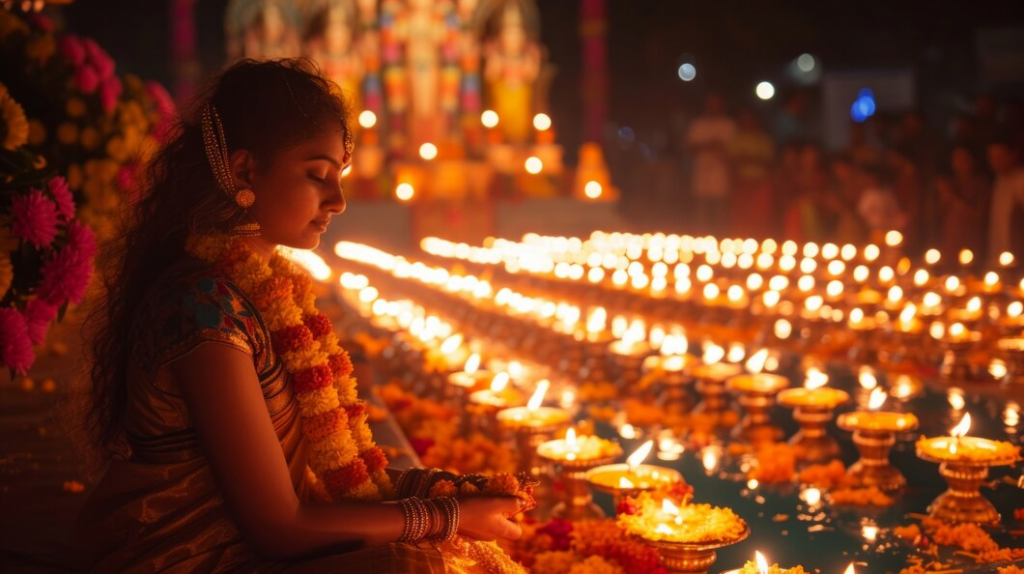The festival of lights celebrated with wishes of prosperities
 The Nepal Weekly
The Nepal Weekly  October 29, 2024
October 29, 2024
The festival of Tihar is celebrated by lighting Diyo (oil lamps) inside and outside the residences on Laxmi Puja or Gai Tihar which is celebrated on the third day and that is on the evening of the new moon night.
Firecrackers are often set off during the festival, although the Nepal Government has banned the use of firecrackers in recent years citing increasing cases of injury and negative impact to the air quality.
Tihar is the second biggest Nepali festival after Dashain, and is usually allocated a three-day-long national holiday from Laxmi Puja to Bhai Tika. The festival is considered novel in that it shows reverence to not just the gods, but also to animals such as crows, cows, and dogs that have long-lived alongside humans.
The first day of Tihar is called Kaag (crow) Tihar. Crows and ravens, believed to be the messengers of the death god Yama, are worshipped with offerings of grains, seeds, and sweets placed on the roofs. Dhanateres and Dhawantari also coincide on the of Kaag Tihar. Dhanateres is the day considered to be a good day to purchase golden and silver ornaments and other household items. Dhanwantari, the father of Ayurveda is also remembered on this day as well.
The second day is called Kukur (dog) Tihar, on which people practice puja. On this day, all dogs, whether pets or strays, are offered treats and worshipped by placing a Tika on their forehead and garlands of marigolds around their necks. This day celebrates the special relationship between humans and dogs. According to Mahabharat, at the doors of heaven, Yudhishthira refuses to enter without the dog, who reveals himself to be the god Yama.
The morning of the third day is called Gai (cow) Tihar. The cow is an especially important animal in Hinduism and is considered sacred. Nepali Hindus people show their gratitude to the cow by feeding them treats and worshipping them.
Rather, the third day is considered the most important day of the Tihar festival. Lakshmi, the patron goddess of the festival, is welcomed into homes that have been cleaned and the doorways and windows decorated with garlands made out of marigolds. Diyos are put up all around the home, especially in doorways and windowsills, while electric lights are draped over houses in the belief that the goddess will not visit dark homes. A special puja is offered to Lakshmi in the evening, wishing for wealth, prosperity and good health.
On the fourth day the Hindus perform Govardhan Puja, which is prayer offered to the holy Govardhan mountain. A pile of cow dung is taken as representative of the mountain and worshipped.
The fourth day of Tihar also generally coincides with the first day of the Nepal Sambat calendar. The Newars celebrate Mha Puja on this day which is a unique tradition where the self and the soul within is worshipped.

On this day, all the members of the Newar families sit in a row, each member facing a fully decorated mandala. Irrespective of age or sex, all the family members are worshipped in turn by the eldest woman of the family. The mandala is a series of concentric circles, each drawn in turn by water, oil, rice, paddy, and yellow and red powders. At the centre of each circle, a compact group of five circle in drawn, each covered by paddy and rice, decorated with flowers and ritual thread, known as Jajanka. The inmates of the family are each offered a burning oil-fed wick known as khelu-itaa. Originally, it measured equal to the length (dhul) of a human face (khe). Finally, the auspicious sagun is offered, consisting of whole boiled-and-fried egg, accompanied by other makaras—matsya (fish), masa (meat), madya (wine), fried ginger (mudra) and bean cake (maithuna). The eldest woman of the family wishes each member of the family a long life-a wish symbolized by the offer of a present consisting of walnuts, jackfruit, common citron, and above all gwae swan, the long-lasting nut-shaped velvety flower.
The Newar community ushers in a sacred moment known as Nhu Dan or New Year. This celebration of a new year is rooted in the lunar Nepal Sambat calendar. In the heart of this cultural celebration lies Mha Puja, a celebration where the self becomes the altar, and offerings are made to one’s existence.
1145 years before, when Nepal Mandala was ruled by under the Lichhavi dynasty, a visionary person Shankhadhar Sakhwa, birthed Nepal Sambat, freeing the oppressed from the shackles of debt and commenced a new Lunar based calendar.
The fifth and last day of Tihar is called Bhai Tika. On this final day, which is celebrated with much fanfare across the country, brothers and sisters mark their special bond by worshipping each other with the exchange of gifts to each other.






